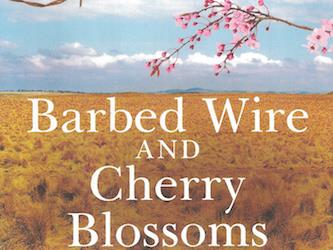During the Second World War there was a Japanese prisoner-of-war camp in Cowra, New South Wales. In August 1944, the Japanese soldiers imprisoned there staged a breakout, resulting in the deaths of more than 200 and injuries to more than one hundred. All the escaped prisoners were recaptured. This attempted escape from prison was not a protest against conditions. It sprang from the Japanese philosophy that it was utterly disgraceful to be taken prisoner, that a soldier’s duty was to win or die.
Barbed Wire and Cherry Blossoms is the story of what might have happened if one of the Japanese prisoners had not wished to die and had instead escaped and evaded capture and been hidden, fed and protected by the local Aboriginal people living at the nearby Erambie Station.
The reader is taken back not only to an Australia at war but to the time of the White Australia Policy, with a government and community that for the most part treated Aboriginal people as less than human. The Japanese prisoners of war were better fed and the Italian prisoners of war had more freedom of movement than the Aboriginal people at Erambie.
The Australian government is seen by the local Aboriginal population, with some justification, as their enemy. So it is not surprising they are willing to shelter another enemy of the government – Hiroshi, the escaped Japanese prisoner of war – in spite of the risks of doing so. Remember the old proverb: ‘the enemy of my enemy is my friend’.
Mary is a young Aboriginal woman who works for the Erambie Station boss, Mr Smith, and helps his wife with the housework and childcare. This gives her access to newspapers and books and contributes to her education. Hiroshi is being sheltered by Mary’s family and she is given the job of smuggling to him what little food they can spare. As these two young people get to know each other better it is not surprising that they fall in love:
In only a month they have reached a place where silence is comfortable but rare, where the exchange of food and a newspaper is secondary to the exchange of a smile or a warm glance, where the sound of Hiroshi’s voice brings peace to an existence that is far from peaceful.
As Mary and Hiroshi’s relationship slowly blossoms, the reader is given extensive insight into the lives of Mary’s parents, siblings, aunts and uncles. This is very interesting for those who want to improve their knowledge of life on a station settlement in the 1940s but it also has the flavour of an historian looking at the past. The plot is interesting but would have benefited from a substantial sub-plot to enliven the action.
While the pace of this novel may be slow, it deserves a place on the bookshelves of those interested in Aboriginal affairs and Australia’s more recent history.
3 stars
Barbed Wire And Cherry Blossoms by Anita Heiss
Simon & Schuster Australia
Trade Paperback, 288 pages
RRP $19.99





